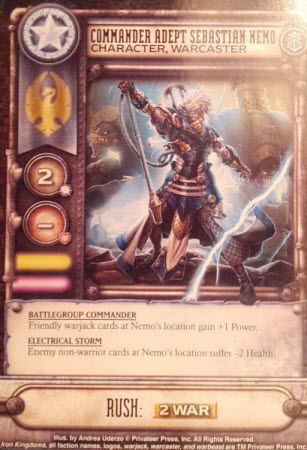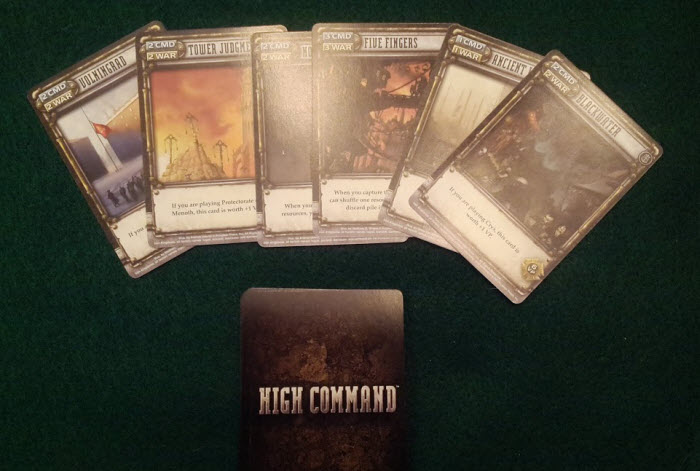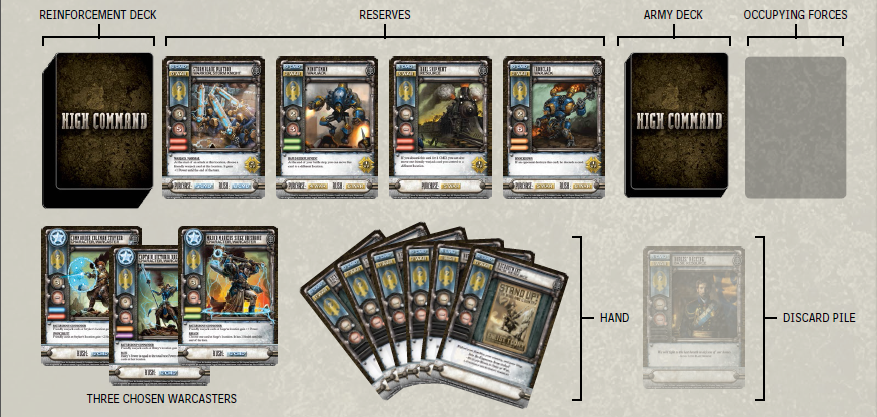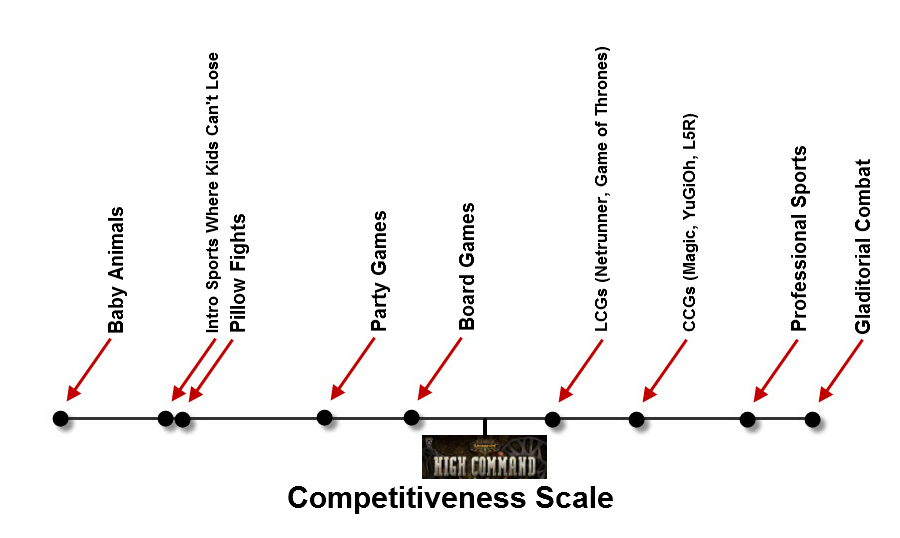Note: This review pertains to the Warmachine factions of the High Command card game. You can see a parallel review with references to the Hordes factions on its own review page. Both games are mechanically identical and interchangeable, but their reviews were separated for flavor and future reference purposes.
“Are you sure that was all that was reported?” Lieutenant Caspian turned and looked at the nervous and exhausted runner as he finished his question, but a sinking feeling in the pit of his stomach was proof already knew the answer. “Yes, sir. Only that part of the message was intact before the cables cut out entirely, sir.” He dropped into silence. Lt. Caspian looked down at the hastily scribbled parchment once more, as if staring at the message one more time would reveal an overlooked clue someone hadn’t noticed yet:
— 3 Sentinels and a platoon of Storm Guards caught unawares. Lone Trencher survivor. Badly wounded, but concurs report: Scharde moves. Incursion imminent. Sending Rangers of the 2nd Army, 4th Division for further assessment. Will follow up in 24 hours with update. Suggest doubling the —
“Lt. Caspian, sir, ” the young man finally asked, attempting to break the long pause, “what does it mean?”
The remainder of the message was never delivered. Caspian sighed reluctantly. “War, son. It means war.”
The Premise
On the war-torn continent of Immoren, conflict is everywhere. It’s only fitting that players find themselves thrust headlong into the fray. Players lead and mobilize different factions, bringing to bear their respective warriors and powerful mechanical constructs down upon one another in a brutal quest to control the Iron Kingdoms.
The Rules
Although principally similar to other Deckbuilder[/glosary]s, the setup and play of High Command is slightly different. Namely, players are presented with a series of decisions they must make prior during the setup portion of the game that determines their available card pools.

The warcaster Nemo. His detachments are Yellow and Purple.
To begin, each player chooses of one of four factions in the game: Cygnar, Khador, the Protectorate, or Cryx. Each faction contains five epic leaders, called Warcasters, a set of twelve starting resource cards, and six sets of color-coded card stacks representing available army detachments. Players select three Warcasters of their faction to use.
Each Warcaster is printed with a pair of colored bars. For each Warcaster, players selects a corresponding detachment set of one of its two listed colors. These detachments are combined together to form individual Reinforcement decks. The top four cards of each are revealed, referred to as the Reserves, marking that player’s card pool. Next to those, players place their decks. The first player is either determined randomly or is the one who scored the fewest VP in the last session of High Command. Every player begins with six cards.
The game contains two additional decks: Winds of War and Location. The top of the Winds of War deck is revealed each round setting that round’s conditions, with games of High Command lasting between 11 and 15 rounds. The Location deck contains, well, Location cards, representing various regional territories to be captured for effects and / or victory points.
Turns in High Command are broken up into three steps: Capture, Orders, and Battle. During Capture, if the player has at least two more units at a Location than each other player, that Location is added it to their discard pile and a new one revealed. However, any of the victor’s units at that time are removed from the deck.
In the Orders step, players mobilize troops and add units to their decks. Players may choose the following actions:
- Purchase: Buy a card from their Reserves pool and place it in their discard pile.
- Rush: Pay the rush cost of a card from their Reserves pool and move it directly to a Location. A Warcaster may also be rushed to a Location, but unlike other forces, Warcasters only remain for one attack and then are removed from the game.
- Deploy: Pay the purchase cost of a card in their hand and move it to a Location.
- Refresh: Discard a card from their hand to remove a Reserve card and reveal another.
- Bank: Set aside one card from their hand to be used next turn.

The Five Fingers Location can be used for 3 CMD or 3 WAR points.
Aside from Banking, actions may be done multiple times. The cost to purchase, rush, or deploy a card is specified in either Command or Warjack points and is done by discarding cards from a player’s hand. At the end of Order, the player discards and draws a new hand, adding any Banked card.
Lastly comes the Battle step. Here, players compare their force’s combined power at a Location against the the opposition’s units. Damage is assigned simultaneously, with each player involved assigning damage to one another. When all battles are resolved, it becomes the next player’s turn to unleash their mighty wrath.
The game continues until the Day of Reckoning card from the Winds of War deck is revealed, or until there are fewer Location cards than the number of players. At that point, players count up the VP of all their cards. The person with the highest VP total emerges as the undisputed victor of Western Immoren and the dutiful ruler of the Iron Kingdoms.
Everyone else must bow before them or be destroyed.
A Wolf in Sheep’s Clothing
As a genre, deckbuilders are immensely popular. The concept of a fixed pool of cards to craft individually tailored decks is still fairly young in the world of gaming, having only truly reached widespread recognition with the debut of Dominion in 2008. Prior to that, games revolving around unique decks facing one another was largely limited to CCGs like Magic: the Gathering or Legend of the Five Rings. The inherent problem with collectible card games, however, is that players each require they create their own decks, and those with lots of extra resources or experience can create lopsided advantages. Deckbuilders alleviate these problems by having a self-contained set of cards that vary between games.
Because of this, deckbuilders tend to have far less direct conflict than CCGs. Indeed, part of the style’s overall appeal traditionally is being competitive without being combative – wining without overtly attacking your opponent. Over time, the deckbuilder experience has become more synonymous with board games than with their card game progenitors.
Warmachine: High Command is an exception to that notion of passivity. While it uses the deckbuilding mechanic, it doesn’t possess the lighter spirit of one. Rather, High Command is more of a card-based tactics game that uses deckbuilding as its engine. This may seem like splitting hairs, but it’s an important distinction to make. Much like the world of Immoren, High Command is rife with conflict. The principal way to win is by capturing Location cards, but rarely are they taken uncontested. Skirmishes with other players is a foregone conclusion. In most deckbuilders, players win by creating the best deck engine they can muster. In High Command, you win by smashing in the plated armor of your opponent’s forces at a Location and defending it until the following round.
Either way, you can be sure that Tacticians will enjoy Warmachine: High Command. More tellingly, its degree of tactical know-how and conflict-driven objectives will heavily appeal to Strikers, underscoring that this game is atypical of normal deckbuilders since Strikers are generally mixed on them. Instead, Architects will be the ones torn here, for as much as Strikers shy away from deckbuilders, Architects gravitate towards them. The game still has enough of the card acquisition and deck tuning style that they enjoy, but there’s also multiple combat-centric mechanics they won’t be as keen about. Aside from the skirmish nature of attacking, Architects won’t like that you remove from your deck any useful (and fully-paid for) units used to take a Location. Sacrificing one resource for another, even towards a win, is not their ideal.
On the other hand, Socializers should skip this one altogether. High Command can be a thought-intensive game of moves and countermoves, leading to a lot of focus and strategic decision-making that they won’t find overly enjoyable.
Preparing for War
Warmachine: High Command does a fantastic job of translating the world of the Iron Kingdoms from its minis and tabletop games to a card game, and the flavor is inescapable. From the Warcasters to in-game card combos that mimic the source material, playing High Command against other players lets you experience a pared down Immoren setting. Fans of the Warmachine universe will most certainly appreciate it, as will Immersionists who respect rich and complex worlds – even if High Command only serves as a primer to a far deeper story.
Case in point: Warmachine: High Command centers around the game’s factions that employ techno-magical constructs and their Warcaster leaders, but the game is fully compatible with the fiery nature-based Warlock magi factions (and their massively savage warbeasts) of Hordes: High Command. It’s a decent depiction of the world setting, but it stops short of needing to know any thematic details prior to playing. Knowledge of Warmachine holds no advantage in High Command, though if you are familiar it’s certainly a bonus.

Choose from these luxurious Locations to conquer from!
That said, High Command requires forethought, with you needing to make important decisions before the first turn is even taken. Each faction’s five Warcasters and six detachments can be mixed together in a multitude of different ways, providing a plethora of variety to card choice and diverse strategy that people expect from deckbuilders.
However, in a style of play closer to LCGs and CCGs, your card pool makeup has a direct impact on your chances of winning. Luck will still have a hand in your options every turn (being a deckbuilder and all), but the game largely does not reward random detachment choices and deployment strategies. Daredevils take note: this is not the deckbuilder for you. Warmachine: High Command involves more tactical thinking than it first appears, revealing surprising wealth of depth and replay value to it. That replayability is only really tempered by the less than perfect cardstock; regular play likely will warrant sleeving cards.
Some detachments are better suited for two-player games, for instance, while others are more for 3 or 4-player sessions. Other detachments even incentivize purchasing units worth VP over capturing lots of Locations at all. The caveat to this degree of player choice though is because all of these decisions are made at the onset of the game, experience can play a factor. It will likely take several sessions to fully feel like you have a grasp on the swath of options the game comes with.
The Takeaway
Warmachine: High Command is like Dominion if every card were an Attack card. It offers a compact and tactically-laden experience, and while it comes across a step or two removed from being a card-based wargame, it wisely sticks to the deckbuilder route. Still, Dominion it is not. Ascension it is not. Instead, High Command presents a game that’s part fixed-deck construction and part LCG, all while appealing to both casual and competitive audiences.
Casual groups can appreciate a unique card game that’s rich in the established flavor of Iron Kingdoms, has a high degree of faction customization, and through the battle mechanic provides players with a new way of using the cards in their deck than merely being a card engine. Competitive groups benefit from these things too, but their focus will be in taking the gloves off, diving into the game’s advanced strategic planning, and relegating the deckbuilder aspect to the background. Warmachine: High Command is wonderfully remarkably in that it’s fully capable of supporting either style, and it leaves the choice up to the players. It’s challenging, tense, exciting, and at times, brutal. Yet also accessible. For those seeking a slightly more aggressive deckbuilder than normal, or want a path into Immoren that doesn’t involve a lot of painting, Warmachine: High Command certainly would be worth scouting out.
Warmachine: High Command is a product of Privateer Press.
Cardboard Republic Snapshot Scoring (Based on scale of 5):
Artwork: 3.5
Rules Clarity: 4.5
Replay Value: 4
Physical Quality: 3
Overall Score: 4
Photo Credits: Game Layout by Privateer Press.


